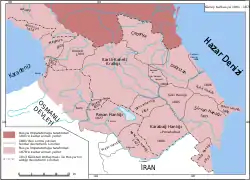خانية قراباغ
خانية قره باغ ((بالفارسية: خانات قرهباغ — Khānāt-e Ḡara-bāḡ)) .وقد إستقر قره باغ في الفترة من 1747 إلى 1805 [3] في المنطقة التي تسمى اليوم بأذربيجان. وكانت دولة تركية[4][5] إقطاعية مستقلة[4][6] وتحت سيادة القاجاريون الإيرانيون[7][8][9][10] بحكم الأمر الواقع. بالإضافة إلى أن وجودها قد استمر في المنطقة التي بين أذربيجان وأرمينيا بجوار منطقة مرتفعات قره باغ.[11] وقد أسسها باناه علي خان. وقد سيطرت الإمبراطورية الروسية على خانية الكرا باغ في عام 1805 من إيران.[12] ولم يستطع الروسيون ضمها رسميا حتى معاهدة كلستان في عام 1813. وبانتهاء الحروب الإيرانية الروسية التي كانت في الفترة من 1804-1813 أعطى حاكم القاجاريون فتح على شاه كراباغ بشكل رسمى إلى حاكم روسيا ألكسندر الأول.[13][14] وقد انتهت الخانية من صفحات التاريخ في عام 1822. وقبل أن تدخل في الإمبراطورية الروسية كانت جزء من خزر الأوبلاست.
| قره باغ | ||||||
|---|---|---|---|---|---|---|
| Qarabağ Xanlığı | ||||||
| خانية قره باغ | ||||||
| ||||||
 خانية قراباغ |
||||||
 خانية قره باغ 1801-1878. | ||||||
| عاصمة | بايات (1748-1750) ثم لاحقا شوشة (1750-1822) | |||||
| نظام الحكم | غير محدّد | |||||
| نظام الحكم | ملكية مطلقة | |||||
| اللغة الرسمية | الفارسية[1][2]، والأذرية | |||||
| اللغة | اللغة الأذرية | |||||
| الديانة | إسلام | |||||
|
| ||||||
| التاريخ | ||||||
| ||||||
| المساحة | ||||||
| المساحة | 17000 كيلومتر مربع | |||||
تاريخها
مصادر
- العنوان : Pavlovich, Petrushevsky Ilya (1949). Essays on the history of feudal relations in Armenia and Azerbaijan in XVI - the beginning of XIX centuries
- العنوان : Russian Azerbaijan, 1905-1920: The Shaping of a National Identity in a Muslim Community — الصفحة: 12 — ISBN 978-0521522458 — اسم المُؤَلِّف بالحروف: Swietochowski, Tadeus
- Gammer, Moshe (1992). Muslim resistance to the tsar. Routledge, 6. ISBN 0-7146-3431-X. [التركية] “In 1805 the khans of Qarabagh, Shirvan and Sheki swore allegiance to Russia.”
- Bertsch, Gary Kenneth (2000). Crossroads and Conflict: Security and Foreign Policy in the Caucasus and Central Asia. Routledge, 297: "Shusha became the capital of an independent "Azeri" khanate in 1752 (Azeri in the sense of Muslims who spoke a version of the Turkic language we call Azeri today).". ISBN 0-415-92273-9. [التركية]
- Cornell, Svante (2001). Small Nations and Great Powers: A Study of Ethnopolitical Conflict in the Caucasus. Routledge, 67. ISBN 0-7007-1162-7. [التركية]
- Nafziger, E. Wayne, Stewart, Frances and Väyrynen, Raimo (2000). War, Hunger, and Displacement: The Origins of Humanitarian Emergencies. Oxford University press, 406. ISBN 0-19-829739-4. [التركية]
- Encyclopaedia Brittanica Online: History of Azerbaijan Azerbaijan نسخة محفوظة 29 مايو 2015 على موقع واي باك مشين.
- Kashani-Sabet, Firoozeh (May 1997). "Fragile Frontiers: The Diminishing Domains of Qajar Iran". International Journal of Middle East Studies 29 (2): 210.
- Baddeley, John Frederick (1908). The Russian Conquest of the Caucasus. Harvard University: Longmans, Green and Co., 71.
- Avery, Peter; Hambly, Gavin (1991). The Cambridge History of Iran. Cambridge University Press, 126. ISBN 0-521-20095-4. [التركية]
- Abbas-gulu Aga Bakikhanov. Golestan-i Iram (روسي). Vostlit نسخة محفوظة 11 يوليو 2017 على موقع واي باك مشين.
- Swietochowski, Tadeusz (1995). Russia and Azerbaijan: A Borderland in Transition. Columbia University Press, 5. ISBN 0-231-07068-3. [التركية]
- Potier, Tim (2001). Conflict in Nagorno-Karabakh, Abkhazia and South Ossetia: A Legal Appraisal. Martinus Nijhoff Publishers, 1. ISBN 90-411-1477-7. [التركية]
- Croissant, Michael (1998). The Armenia-Azerbaijan Conflict: Causes and Implications. Praeger/Greenwood, 12. ISBN 0-275-96241-5. [التركية]
- بوابة الإمبراطورية الروسية
- بوابة أرمينيا
- بوابة أذربيجان
- بوابة إيران